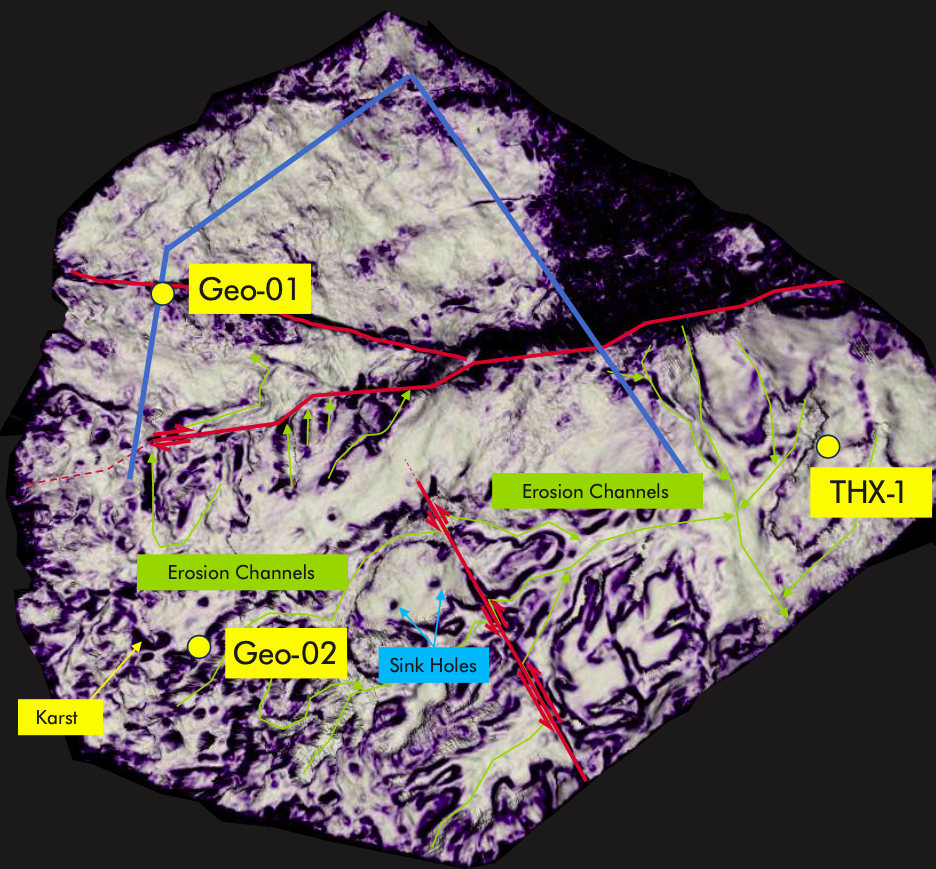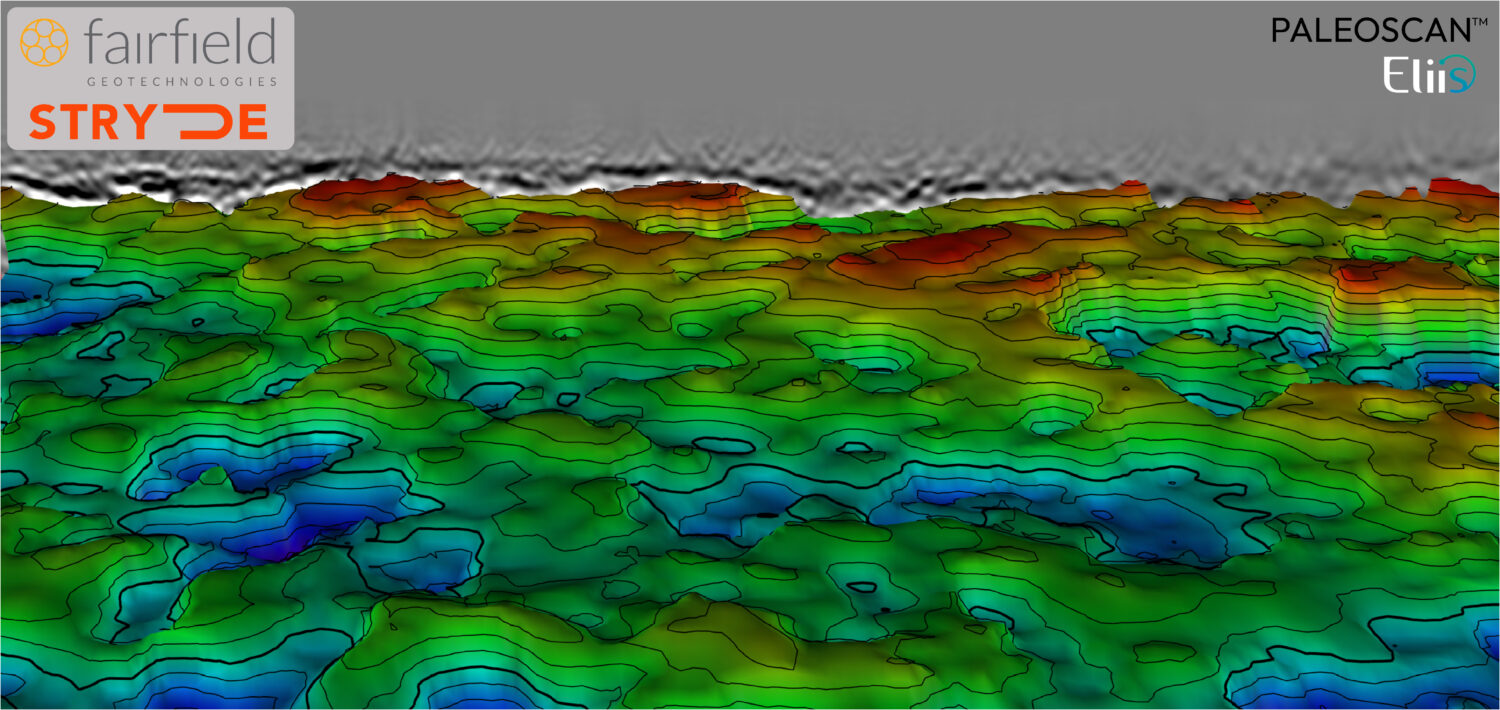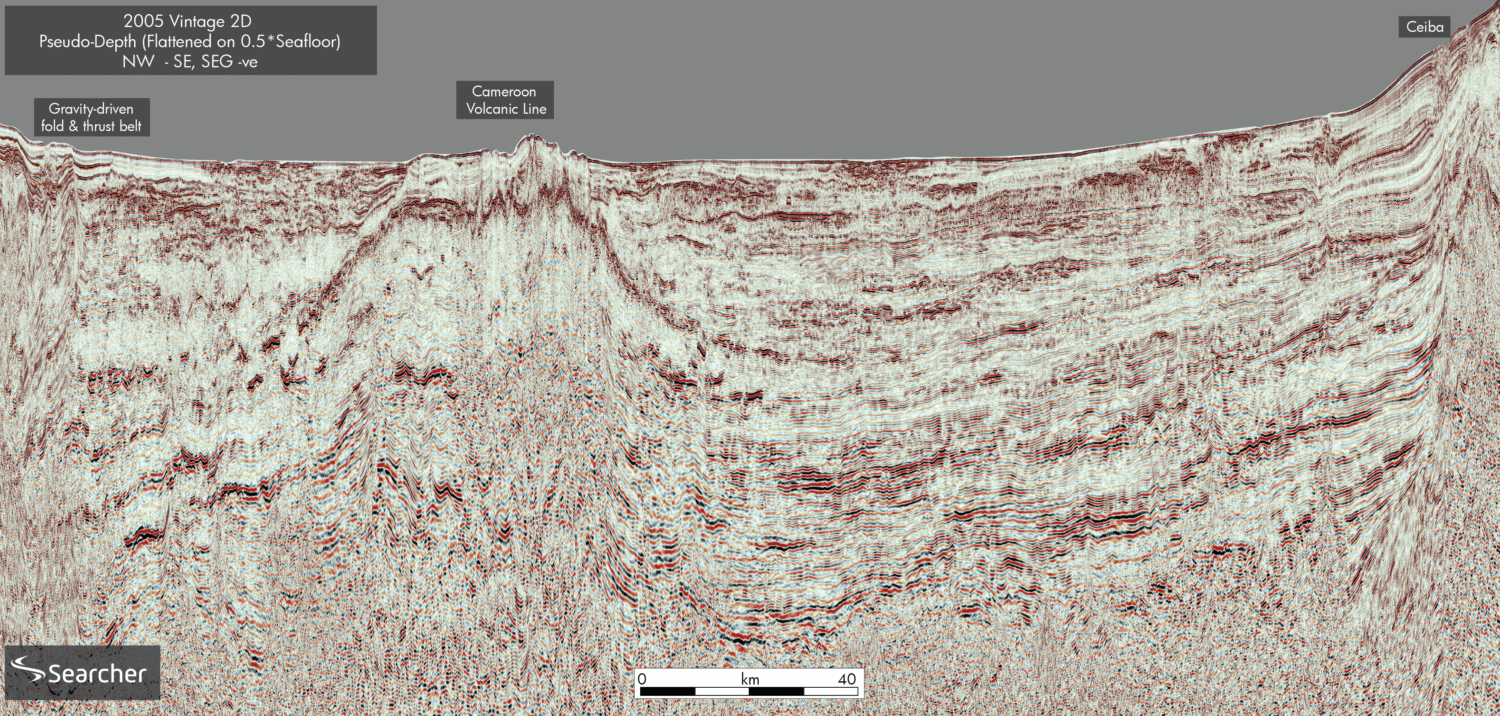
This timeslice below shows the top of the Cretaceous carbonate succession in the Geneva area. Observe the erosional channels, karst features and sinkholes, plus the major fault zones dissecting the interval. Without the 3D survey, these features would have been much harder to map, as the results of the Geo-01 and Geo-02 boreholes have proven. Geo-01 drilled into a fault zone and resulted in high fluid flow on test, but the Geo-02 did not find a similar fault zone. However, it did unexpectedly encounter the sandy and porous infill of a significant karst feature that can be used for seasonal storage of fluids given the porous and confined nature of the infill.
This rapidly led to the conclusion that a 3D seismic survey was required to both map the faults in the Geneva area better, as well as gain more control on the distribution of the karstified zones that can be used for seasonal storage. With this 3D coverage of sedimentary features and faults now available, the geological model can be refined to an extent that future well planning can be carried much more accurately, minimising the risk of drilling into tight formations. Two new wells have already been planned in the Malm and Dogger units and if successful these drillings will move directly from the exploration phase to the exploitation phase by 2026.
Cost-effective 3D seismic acquisition in a dense urban environment
Covering an entire Swiss city, including its surrounding vineyards, neighbourhoods in France, a lake, an international airport and many other restricted places such as ONU, CERN, embassies and a golf course, that is what the Geneva 3D seismic acquisition was about.
To properly image the shallow targets, a dense survey with 160 m between receiver lines and varying source line spacing, from 160 m to 240 m, was designed. With some narrow streets and exclusion zones due to dense buried networks and sensitive buildings, it would be very challenging to conduct a conventional acquisition with fleets of 2 to 4 vibrators as it would result in an excessively high level of cancelled vibrated points. Therefore, a single vibrator acquisition with denser sampling was chosen.
A high-productivity technique
This decision was taken after a 2D test, which demonstrated that dense single-vibrator acquisition can properly image the deepest targets. This kind of acquisition needed to be combined with a high productivity technique in order to be conducted in a limited timeframe for economic reasons and to limit exposure to the local population.
Smart Seismic Solutions (S³) proposed its established high-productivity technique, SRS (Simultaneous Random Sweep), which is very well suited for geothermal seismic acquisition usually conducted in urban environments.

This technique uses dedicated broadband random sweep for each vibrator. One of the advantages of random sweep is that it limits the peak particle velocity and it avoids the resonance phenomena which could result in damaging infrastructure. The acquisition is carried out with up to 10 vibrators working simultaneously, vibrating as soon as they are in position, without classical limitations in space and time.
It avoids any need for real-time synchronisation between the vibrators, which would limit the productivity and add complexity to the operations.
Instead of conventional correlation, Ground-Force deconvolution combined with a deblending algorithm is used in order to retrieve the seismic response of each vibrator free of interferences. This is made possible due to the use of a unique random sweep for each vibrator which weakly correlates with the other vibrator’s sweep. The residual interference is then subtracted by the algorithm.
Another advantage of the SRS technique is its ability to strongly attenuate transient noises from cars, trucks and trains, which are the main strong sources of noise in an urban area.
Real-time transmission
On the receiver side, Sercel WiNG nodes were selected. The nodes are equipped with the latest generation low-noise Mems accelerometers. They form a mesh network which has the ability to transmit in near real-time the position, status and tilt of the whole recording spread to one centralized QC office. This feature is of extreme importance in a populated area where nodes may be moved by malicious or just ignoring people. It helps to replace quickly moved or defective units and to find them when they have been thrown away, minimizing the potential losses of data and material.
Finally, in the lake an 840 cubic inch airgun source and 530 cabled hydrophones were selected to avoid a loss of illumination in an important part of the prospect.
Anthropogenic noise
The survey took place in a populated area with high levels of anthropogenic noise, especially in the centre of the city and along the main transportation axes. After tests showed that noise levels decreased by an average factor of 3 during the night and up to a factor of 10 in the noisiest areas, it was decided to record during night in order to maximise the S/N ratio without using large arrays of heavy vibrators.

Operations
Four different types of vibrators were mobilised in order to adapt the source to the different terrain conditions. In the city area, small and medium vibrators such as IVI Envirovib and Prakla VVA were used, whereas heavier vibrators, AHV IV and Hemi 48 were reserved for land use or major roads.
The recording operation took place between 7 September and 16 October 2021, with an average production of 1300 VP per day and a peak production at 2000 VP per day. The production was usually limited by receiver layout/pickup. An average spread of 20,000 nodes was maintained on the field with a rotation of 1,500 traces per day.

This high productivity could be reached thanks to simultaneous shooting, strong efforts on the permitting side, and pre-planning, which was done months in advance but had to be reassessed on the fly in some parts of the city.
Careful pre-planning of vibrator displacement was done on a daily basis. Each vibrator was escorted by a traffic control team and a PPV (peak particle velocity) team that stops the vibration if the ground velocity exceeded pre-defined and legal thresholds.
Some VP were acquired in very uncommon areas such as an international airport and a golf course where carpet rotation was put in place in order to preserve the integrity of the fairway.
Doing it smartly
With the energy transition progressing, a better understanding of the geology beneath our cities is crucial in order to develop geothermal solutions for heat generation, cooling and heat storage.
These applications have usually lower return on investment than oil and gas and exploration budgets can be more limited. Therefore, only a smart way of acquiring 3D seismic surveys will result in a cost-effective acquisition with limited disturbance.
We would like to thank SIG for the permission to show seismic data and ProGaia for providing seismic images and interpretation.




